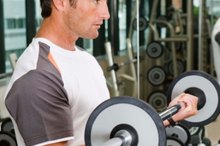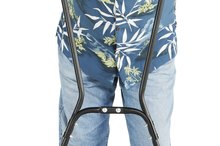What Happens to Your Vessels When You Exercise?
Exercise causes the blood vessels to constrict and dilate at different moments during the activity. These reactions are due to the sympathetic and parasympathetic systems responding to the physical exertion brought about by exercise, McGrawHillEducation.com notes. Poor cardiovascular health impairs blood vessel’s ability to dilate and constrict. So, regular exercise also helps keep your blood vessels flexible and working efficiently.
Vasoconstriction
At the onset of exercise, the sympathetic nervous system causes heart rate to elevate and blood vessels to constrict, according to Fitness.com. This constriction response is called vasoconstriction. During vasoconstriction, blood flow is directed specifically to the muscles to help them work more efficiently. Blood pressure rises to facilitate the body’s increased flow of blood. Reflexes speed up and muscles tense. This allows blood to carry oxygen more efficiently to the muscles and move waste away from muscles.
Vasodilation
Physiological Adaptations to Exercise
Learn More
As oxygen levels drop due to increased muscle use, substances such as lactic acid and carbon dioxide build up. This stimulates a parasympathetic response called vasodilation, McGrawHillEducation.com notes. Blood vessels leading to the muscles dilate to allow easier access to oxygen. Blood pressure drops due to blood vessel dilation. Exercise causes body temperature to rise, stimulating the blood vessels in the skin to dilate, allowing blood to flow there more easily and help get rid of excess heat. As muscle activity is sustained, the sympathetic system is stimulated to cause vasoconstriction once again, News-Medical.net notes.
Vasoconstriction, Vasodilation and Exercise
Doing regular aerobics helps keep the blood vessels flexible. Exercise stimulates vasoconstriction and vasodilation responses in the body to facilitate oxygen delivery to the muscles. This also keeps blood vessels healthy because it prevents the accumulation of cholesterol and substances that potentially compromise function. Warming up and cooling down for three to five minutes helps transition into and out of exercise, according to NorthwesternMemorialHospital.org.
Vascular Disease and Impaired Function
Asperger Physical Exercises
Learn More
Poor diet and an unhealthy lifestyle cause fat and cholesterol deposits to build up along the inner walls of blood vessels, ClevelandClinic.com notes. These substances compromise proper blood vessel function. They narrow blood vessels, restricting blood flow and compromising flexibility. If left unchecked, fat and cholesterol deposits cause potential blockages to form. Vascular disease also impairs the body’s ability to properly constrict and dilate blood vessels, resulting in high blood pressure. Also as people age, blood vessel flexibility generally reduces. One way to keep them flexible is to get regular exercise. Exercise intensity generally goes down as people age. But doing it regularly keeps the heart and blood vessels healthy, and reduces the risk of vascular disease.
Related Articles
References
- ClevelandClinic.com: Vascular Disease
- Fitness.com: Sympathetic and Parasympathetic Nervous Systems
- FitnessGuru.org: Cardiovascular Exercise
- McGrawHillEducation.com: Blood Flow Through Tissues During Exercise
- News-Medical.net: Balance Between Vasodilation and Vasoconstriction in Exercising Muscle May Change with Age
- NorthwesternMemorialHospital.org: Exercise and Your Heart
Writer Bio
Joseph Pritchard graduated from Our Lady of Fatima Medical School with a medical degree. He has spent almost a decade studying humanity. Dr. Pritchard writes as a San Francisco biology expert for a prominent website and thoroughly enjoys sharing the knowledge he has accumulated.








